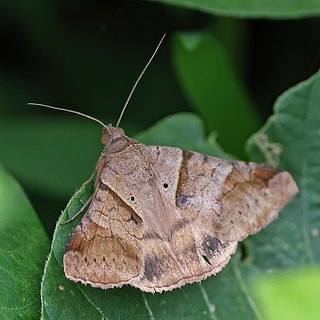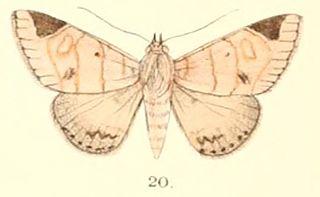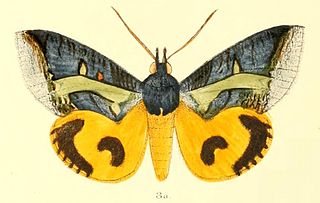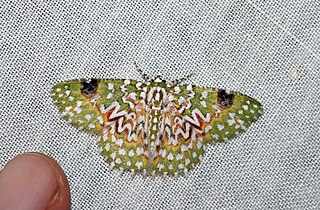
Mocis undata, the brown-striped semilooper, is a moth of the family Erebidae. The species was first described by Johan Christian Fabricius in 1775. It is found in the Afrotropical and Oriental regions, including India and Sri Lanka.

Arsacia is a monotypic moth genus of the family Noctuidae. Its only species is Arsacia rectalis. Both the genus and species were described by Francis Walker, the genus in 1866 and the species in 1863. It is found from the Indo-Australian tropics of India, Sri Lanka to Queensland and the Solomon Islands.

Dordura is a monotypic moth genus of the family Noctuidae erected by Frederic Moore in 1882. Its only species, Dordura aliena, was first described by Francis Walker in 1865. It is found in the Indian subregion, Sri Lanka, Myanmar, Thailand, Peninsular Malaysia, Sumatra, Borneo and New Guinea.
Aquita acontioides is an Asian member of the family Nolidae.

Eudocima homaena is a moth of the family Erebidae first described by Jacob Hübner in 1816. It is found in the Indian subregion, Sri Lanka, Myanmar, Taiwan, the Nicobars, Peninsular Malaysia, Borneo, the Philippines and on Christmas Island. It is a major pest on orange plants.

Scopula divisaria is a moth of the family Geometridae. It is found from the Indian subregion, Sri Lanka to Taiwan and Sulawesi.

Chiasmia emersaria is a moth of the family Geometridae. The species was first described by Francis Walker in 1861. It is found in India, Nepal, northern Thailand, China, Sri Lanka, Japan and the Ryukyu Islands.

Eucyclodes gavissima, the Oriental orange banded green geometer moth, is a species of moth of the family Geometridae described by Francis Walker in 1861. It is found in the Indian subregion, Sri Lanka, Bhutan, western China, Taiwan, Vietnam, Sumatra and Borneo.
Trichoplusia lectula is a moth of the family Noctuidae first described by Francis Walker in 1858. It is found throughout Asia, including the Indian subregion, Sri Lanka, Thailand, Borneo, Java, Japan, as well as Western Australia and Queensland.

Mnesiloba dentifascia is a moth of the family Geometridae first described by George Hampson in 1891. It is known from the Oriental tropics.

Ischyja manlia is a species of moth of the family Noctuidae first described by Pieter Cramer in 1776. It is found in the Indian subregion, Sri Lanka, Myanmar, Thailand, China, Okinawa, Sundaland, Sulawesi, Korea, the southern Moluccas, Australia (Queensland) and Palau. Adults pierce the skin of fruit to suck the juice.

Gesonia obeditalis is a species of moth of the family Noctuidae first described by Francis Walker in 1859. It is found from eastern Africa, the Seychelles, the Maldives and the Oriental tropics of India, Myanmar, Sri Lanka east to the Philippines, the Sula Islands and Australia. The adult moth has brown wings with a scalloped dark brown band near the margin. The hindwings are similar in pattern to the forewings but are a paler shade of brown.
Gymnoscelis imparatalis, the flower-looper moth, is a moth in the family Geometridae. It is found from the Indo-Australian tropics of India, Sri Lanka, east to the Society Islands and the Marquesas Archipelago. The habitat consists of both lowland and montane ecosystems.
Gymnoscelis deleta is a moth in the family Geometridae. It is found in India, Korea, Japan, Taiwan and probably in Sri Lanka according to Hampson.

Rhinoprora palpata is a moth in the family Geometridae. It is found in the Indian subregion, Sri Lanka and western China, as well as on Java, Borneo and Taiwan. The habitat consists of mountainous areas.

Hypomecis separata is a species of moth of the family Geometridae. It was first described by Francis Walker in 1863. It is found in Sri Lanka, India, Java and Borneo.

Risoba repugnans is a species of moth of the family Nolidae first described by Francis Walker in 1865.
Epiplema albida is a species of moth of the family Uraniidae. It was described by George Hampson in 1895. It is found in India, and Sri Lanka.

Erygia apicalis is a moth of the family Erebidae first described by Achille Guenée in 1852. It is found from the Indo-Australian tropics of India, Sri Lanka to Japan, Australia and the Solomon Islands. The habitat consists of lowland areas, including dry heath forests and softwood plantations.
Eupterote patula is a moth in the family Eupterotidae. It was described by Francis Walker in 1855. It is found in Thailand, Myanmar and India.













